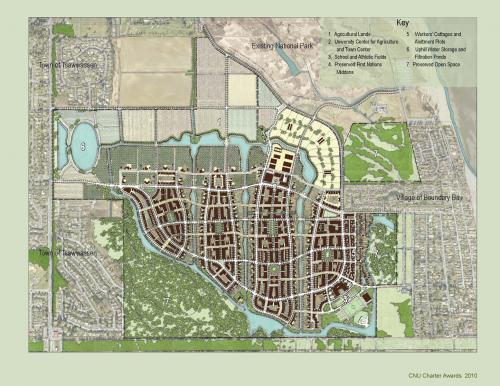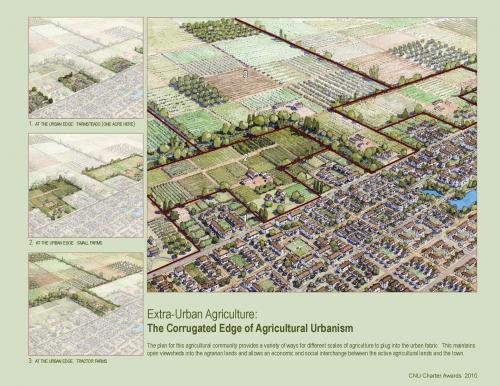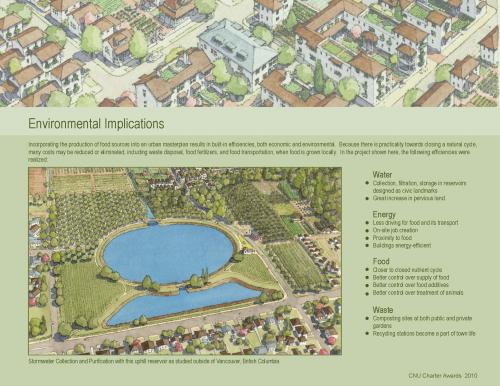
Southlands: Agricultural Urbanism
Location: Tsawwassen, British Columbia, Canada. NA
The town of Tsawwassen has too-high a housing cost, as a result of a homogeneous dominance of large-lot, single-family housing. This justifies an expansion into farmland to accommodate additional housing. The urban expansion connects the town of Tsawwassen with the adjacent resort village of Boundary Bay on the west and the east of the site, and the U.S. border to the south. The existing farm is of mediocre soil quality and is currently dedicated to low-value crops. It is crossed by the road to Boundary Bay and has a system of drainage canals.
The basic premise of Agricultural Urbanism is that when farmland is built upon, one third will be urbanized while the production of the whole will be tripled. This is achieved by intensifying the agricultural activity across the Transect, from window boxes, balcony and roof gardens in the more urban Transect Zones, to the progressively larger community gardens, yard gardens, small farms, and ultimately large farms
in the more suburban and rural Transect Zones.
The condition specified in the Association Document is that every dwelling, in some measure, participates (or allocates that portion of the household budget which is dedicated to maintaining ornamental landscaping) to the production of food. The larger farms may be centrally managed with connection to distribution systems in the City of Vancouver. A heavy equipment yard will be held in common, as will be facilities
for the processing and storage of high value food. Part of the town square also has the new facilities of a local university’s agricultural department. This is NOT urban agriculture. This is agricultural urbanism in which all aspects of the urbanism are
focused on the production of food, including the terms of the Property Owners’ Association.
Two plans were presented in the charrette in May 2008. One further plan has been developed for further consultation. This project is now in the permitting process.
Lessons learned: There is a very positive attitude towards agricultural urbanism on the part of those who are environmentally concerned, those who would enjoy the society of a shared endeavor (front gardens were introduced for the purpose of social discourse—a role not unlike that of a porch) and for those who wish to take precautions with their health and welfare. Agricultural projects must be precise both in terms of the land cultivated, and in the management of it. Urbanism must be cohesively designed. By concentrating development, land is liberated for agricultural use. The Transect will help organize the appropriate placement of agriculture at the scale of both the master plan and the architecture of buildings. Agriculture is often better viewed from afar; within urban areas, buildings may be used to control views and protect the product, though special attention must be paid to sunlight access. Similarly, at the scale of the lot and building, spaces should be designed to accommodate growing, upkeep, storage and refuse.
Transect Zone(s): T1 natural, T2 rural, T3 sub-urban, T4 general, T5 center.
Status: Proposed
Project or Plan's Scale: Region
Features: Affordable/subsidized housing, Civic buildings & parks, Mixed uses, Sustainable infrastructure.
Land area (in acres): 536
Total built area (in sq. ft.):
Total project cost (in local currency):
Retail area (in sq. ft.):
Office area (in sq. ft.):
Industrial area (in sq. ft.):
Number of hotel units:
Number of residential units (include live/work): 2000
Civic uses (type and size): Plazas, squares, agricultural lands, meeting spaces
Parks & green space (in acres):
Residential types: Townhouse/rowhouse/maisonette, Large lot detached, Live/work.
Project team designers: Christina Miller, Duany Plater-Zyberk & Company, LCC
Project team developers: Century Group (Client), Bill Dennis Town Design, Urban Proportions, Inc., New Urban Guild, Whole Town Solutions, Counterpoint Communications, Ekistics Town Planning, Foxtrot Farms, Holland Barrs Planning, The Hulpert Group, Kwantlen Polytechnic Institute for Sustainable Horticulture, MVH Urban Plnning
Previous site status: Undeveloped greenfield
Starting/Ending date of construction/implementation: -




